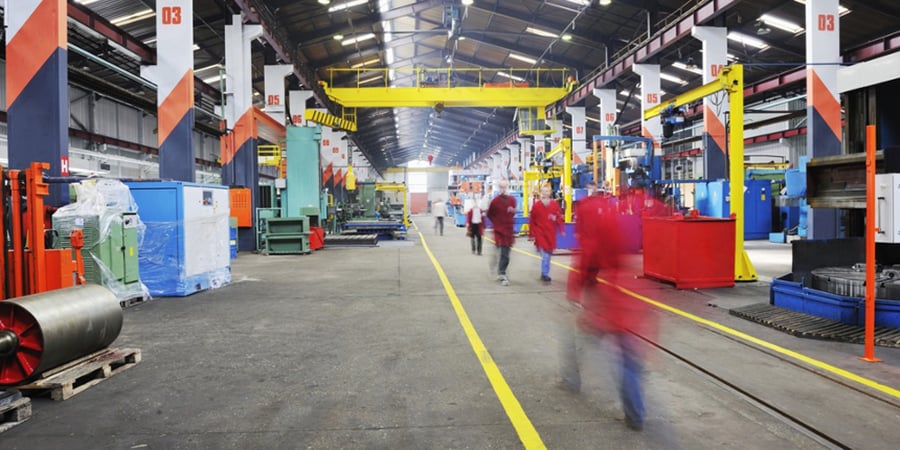2019 Manufacturing Industry Outlook — 5 Trends to Watch
January 16th, 2019
3 min. read

The year 2019 will mark the close of another decade, and manufacturing is expected to end on a high note despite concerns over its demise only a few short years ago. The manufacturing sector drove nearly 12% of the U.S. economy in 2018, according to the Bureau of Economic Analysis, and manufactured goods comprise half of U.S. exports.
What’s the outlook for manufacturing in 2019? While there’s no crystal ball, there are indicators from the year that can provide insights into many opportunities and challenges that the industry will likely face, particularly in these five categories.
1. Manufacturing Growth Continues
The Manufacturers Alliance for Productivity and Innovation Foundation (MAPI) forecasts that manufacturing will grow faster than the general economy, and production will increase 2.8% from 2018 to 2021. Much of this growth will depend on the strength of the U.S. economy. With interest rates expected to climb, the dollar is expected to strengthen, which could have negative implications on exports. For smaller manufacturers that rely more heavily on domestic sales and supply chains, however, there is a little less uncertainty and growth should remain strong.
2. Labor Shortage Still a Concern
While growth is certainly a good thing, it poses an even greater threat of continued labor shortages. Despite the U.S. having 12.75 million manufacturing jobs that offer strong wages, the majority of manufacturers have jobs that are going unfilled because they can’t find qualified workers. The result could translate to 2.4 million vacant jobs between 2018 and 2028, costing the industry billions.
As it stands today, 80% of manufacturers already report a shortage of qualified applicants for skilled and highly-skilled production positions. Manufacturers will need to deploy strategic hiring practices to overcome the labor shortage before it reaches critical mass and negatively impacts their abilities to meet production demands even further.
3. Focus on Safety and Compliance
Environment, Health and Safety (EHS) directors are expected to increase their budgets in 2019, emphasizing ongoing initiatives to improve worker conditions and safety protocols in construction, engineering and manufacturing. Two areas expected to see increased adoption are wearable safety technology and improved personal protection equipment (PPE) to further develop a strong safety culture.
The Occupational Safety and Health Administration (OSHA) also has new reporting rules for 2019 regarding the submission of injury data. Beginning in 2019 and every year thereafter, OSHA Form 300A containing data from the previous year must be submitted by March 2 for establishments with 20-249 employees in certain high-risk industries.
Compliance with OSHA safety regulations and other compliance requirements will be a growing challenge for industries, so it’s important to remain informed and ensure business best practices are followed.
4. Adoption of Technology
There are many predictions about the role of technology in the manufacturing industry, some more extraordinary than others. What’s certain, however, is that the Industrial Internet of Things (IIoT) will see increased adoption in coming years. The pace at which software, machine learning, artificial intelligence and robotics is advancing is faster than most organizations can keep up with.
As difficult as it is to keep pace, those who embrace the future of technology for their enterprises can expect improved outcomes. One survey indicated that 48% of participants experienced better inventory control and 40% had improved production plan performance. There’s no doubt that technology can allow for leaner capabilities, higher production and better capacity planning, but all this connectivity can also pose risks. Cyber attacks skyrocketed in 2018; protecting your systems against the liability risks associated with cyber-crime must be an integral part of your 2019 technology strategy.
5. Continued Trade Wars
No matter your political leanings, the National Association of Manufacturers is generally pleased with the administration’s intentions to reduce taxes and regulations and its call to improve the nation’s infrastructure. The trade wars, on the other hand, including changes to the Trans-Pacific Partnership and North American Free Trade Agreement (NAFTA), have hurt many manufacturers, and the onslaught of tariffs continues to have an impact by creating pricing volatility and uncertainty.
Since the political climate and subsequent consequences will remain largely out of their control, manufacturers must ensure that mitigating other top risks in their organizations remain a priority.
While uncertain, exciting times are ahead for the manufacturing industry. Embracing the future while simultaneously addressing potential associated risks can reap benefits and increase the likelihood of success. Take a look at the unique risks your company faces to build your strategy and tackle these risks today to keep your company moving in the right direction. We love to visit clients and friends to perform company risk assessments tailored to your operations. Request yours today by clicking the link below.
Jeff Miles, Strategic Risk Advisor
Jeff Miles is a strategic risk advisor at McClone. He joined the company in December 2014 and is responsible for assisting individuals and businesses in protecting their financial futures. Through education and comprehensive planning, he works with clients to ensure their legacies and businesses continue as intended. Jeff came to McClone with over 20 years of experience in the financial services industry and specializes in life insurance and long-term care. He utilizes a variety of insurance products and strategies in developing and implementing financial risk management plans to protect his clients. Miles received his Bachelor of Business Administration from University of Wisconsin- Madison. Jeff and his wife currently reside in Appleton and are actively involved in the community and their church.
Topics:







